Native to various regions of California, and Northern California in particular, these plants are all climate-appropriate in moderate inland areas of Northern California. Others will work in coastal areas too. From majestic manzanita to colorful Oregon grape and striking western redbud, all of these plants add beauty and seasonal interest and attract wildlife. They have been chosen for their wildlife value, minimal maintenance, gardening ease, low water requirements and availability in nurseries.
Not in California? Browse plants native to more regions of the U.S.
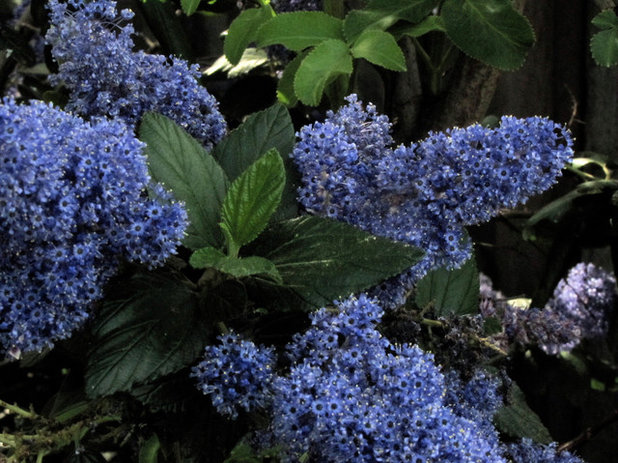 California Lilac
California Lilac (
Ceanothus spp)
Native across North America from southern Canada to Guatemala in dry ridges and slopes, in many plant communities below 10,000 feet
The deep cobalt-blue to delicate powder-blue flowers of California lilac dance with pollinators in the early spring, while the dark foliage stays evergreen throughout the year. There are a number of species, cultivars and hybrids of California lilac to choose from, including ground covers, medium-size shrubs, large shrubs and extra-large shrubs. My personal favorites are ‘Dark Star’ and ‘Julia Phelps’, which are large shrubs with tiny textured leaves; the robust ground cover ‘Yankee Point’; and the tree-like ‘Ray Hartman’, which quickly grows to 10 to 20 feet tall. Ceanothus requires excellent drainage, and most species want no summer water once established.
See how to grow ceanothus
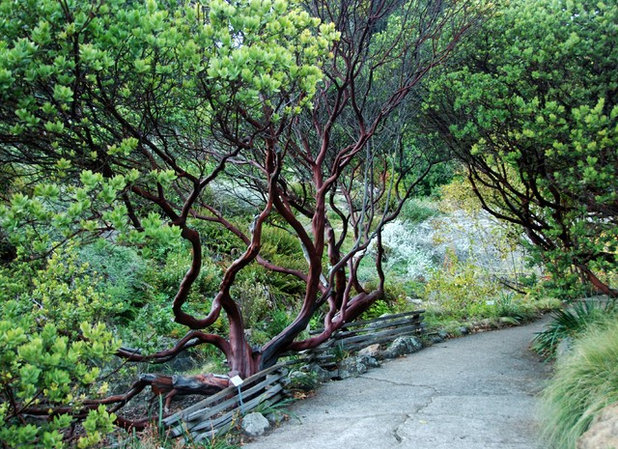
Pete Veilleux, East Bay Wilds
Parry Manzanita(
Arctostaphylos manzanita)
Native to California chaparral, grasslands and woodlands from Mount Diablo north to Humboldt and Shasta counties; as with many manzanita species, Parry manzanita will perform well in gardens in all zones except deserts and high mountains
Manzanitas burst forth with delicate white urn-shaped flowers early in the season, sharing their nectar with hummingbirds and early pollinators as a sweet reminder that all is well in winter and early spring. Small apple-like fruits appear after the bloom, attracting songbirds and other critters; the fruit also makes a delicious manzanita cider.
Group manzanitas to create a large screen or a naturalistic grove that provides cover for wildlife, or plant an impressive single specimen. Plant it on a sunny, well-drained slope or mound it where it will get infrequent to no summer water once established. With its characteristic deep red peeling bark and sculptural branches, Parry manzanita slowly grows to 10 to 12 feet tall and wide. It is a handsome and rugged evergreen that will add drama to any low-water garden.
See how to grow Parry manzanita
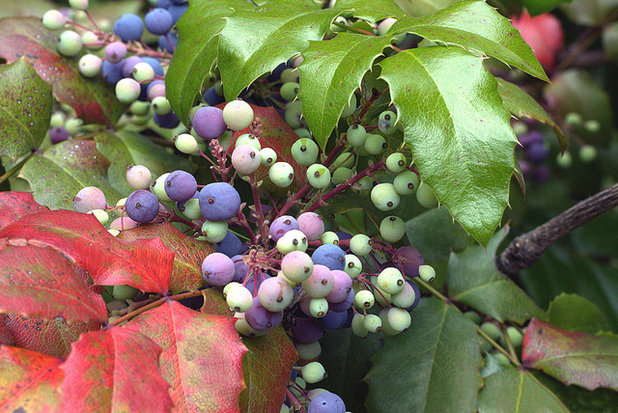 Oregon Grape
Oregon Grape
(
Mahonia aquifolium)
From many plant communities in California and some regions in Oregon, Washington, Idaho, Montana, British Columbia and northern Mexico. (Prohibited in Michigan due to black stem rust.)
This easy, colorful evergreen provides nectar for pollinators and a bounty of fruit for songbirds. Doing best in full sun on the coast and partial shade inland, Oregon grape is not a grape at all. Its clusters of berries change from green to blush, ripening to deep purple to imitate its namesake.
The plumes of bright yellow spring flowers and colorful summer berries could be enough for this drought-tolerant plant to be a great garden selection. But its colorful fall foliage — which it holds on to — makes Oregon grape a must-have for low-water landscapes.
Use Oregon grape in a hedge or as a specimen or an accent. It grows to 3 to 6 feet tall and 4 feet wide, spreading slowly.
See how to grow Oregon grape
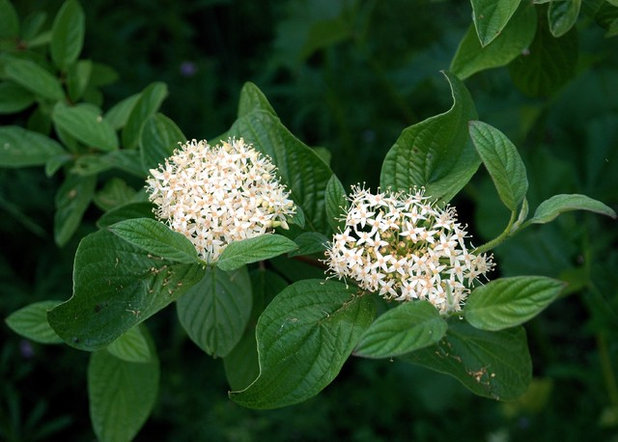
Pete Veilleux, East Bay Wilds
Redtwig Dogwood(
Cornus sericea,
syn.
Cornus stolonifera)
Native in many plant communities throughout California, except deserts, on stream banks and in moist places
As a classic woodland plant in full sun or shade, dogwoods are best known for their elegant creamy-white flower clusters on outstretched branches with bright green leaves. Redtwig dogwood adds a twist. Awakening in spring, blooming in summer and fruiting soon after, redtwig dogwood then becomes ablaze in scarlet leaves from summer to fall, only to drop its leaves to reveal fiery red stems from fall through winter.
The berries of redtwig dogwood attract songbirds and other wildlife, while its flowers are a special treat for butterflies. Redtwig dogwood is not drought tolerant and does better sited next to a natural spring or waterway, rather than receiving irrigation every 10 to 14 days. It grows to 7 to 9 feet tall and up to 12 feet wide.
See how to grow redtwig dogwood
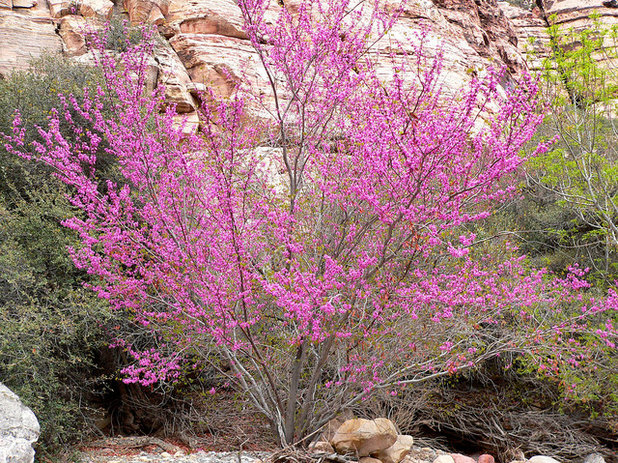 Western Redbud
Western Redbud
(
Cercis occidentalis)
Native to many plant communities in Northern California, the Sierras, the San Joaquin Valley and the extreme southwest of California to Utah and Arizona, including slopes, canyons and ravines next to streams or springs
Western redbud’s showstopper pink to magenta flowers sprout from deciduous branches after a long winter’s sleep; its heart-shaped leaves follow. Add these lovely attributes to western redbud’s vase-like shape, large cinnamon seedpods and gray winter bark, and you have an expressive shrub to small tree through all four seasons.
Sometimes slow to become established, western redbud requires well-drained soil. It does best with full sun and, once established, with water every two weeks. Yet western redbud can also tolerate partial shade and some drought. Reaching anywhere from 3 to 15 feet tall and wide, it can be used as a screen or specimen. Western redbud shares its delectable nectar with hummingbirds, native bees and other pollinators. Plant it with blue-flowering ceanothus for a stunning spring display.
See how to grow western redbud
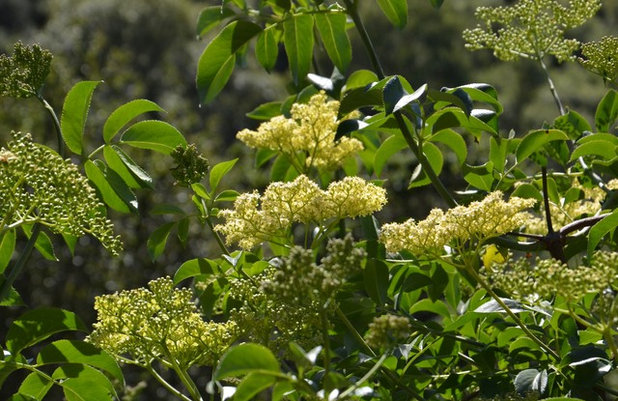
Pete Veilleux, East Bay Wilds
Blue Elderberry(
Sambucus nigra ssp
caerulea)
Native through much of California to New Mexico in canyons, valleys and open places in many plant communities; prefers moist riparian habitats
Extremely fast growing and easy, blue elderberry is one of the best shrubs for songbirds. Many bird species are attracted to its tasty fall berries that appear dark blue from the powder coating. Pretty, lacy umbels of creamy flowers emerge in summer, followed by fruit. Although it can be drought tolerant once established, blue elderberry grows best next to a natural waterway or spring. If irrigation is necessary once it’s established, every two weeks during the summer is ideal.
Blue elderberry can reach up to 20 to 25 feet tall but is 8 to 15 feet tall in most gardens. It will do well in partial shade but is most productive in full sun. Use blue elderberry as a hedge, screen, windbreak, large shrub or small multitrunk tree.
See how to grow blue elderberry
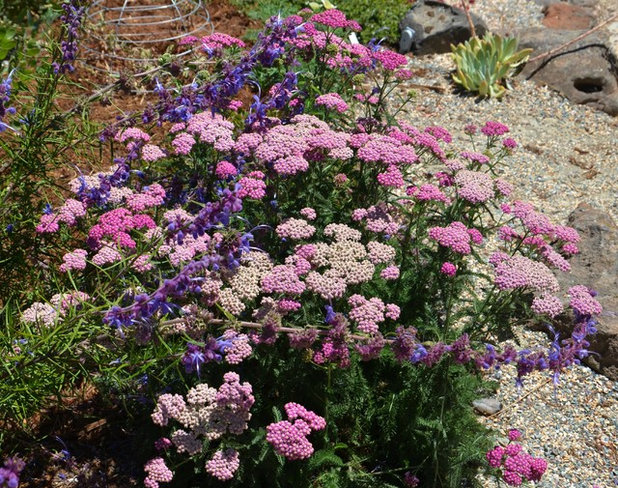
Pete Veilleux, East Bay Wilds
Yarrow
(
Achillea millefolium)
Common throughout California, except in deserts; also native to many temperate regions of the Northern Hemisphere in Asia, Europe and North America
Yarrow is another workhorse in the garden, attracting lots of good bugs while also repelling bad bugs; it’s an excellent plant for habitat and vegetable gardens. Its long-blooming umbels of fresh white flowers — and ones in a variety of other colors — call to mind a wildflower meadow. Yarrow’s fern-like foliage appears delicate yet is tough enough to be mowed as a lawn alternative. It’s highly variable in height, from 6 inches to 3 feet.
For those in California most interested in using local natives, choose from naturally occurring selections of the California form, including ‘Rosy Red’, ‘Island Pink’ (shown), ‘King Range’, ‘Sonoma Coast’, ‘Shell Beach’, ‘Point Cabrillo’ and ‘Calistoga’ with gray foliage. Use yarrow in a meadow, as a slope stabilizer or lawn alternative, or in a habitat or vegetable garden.
Although native to many parts of the world, yarrow can be invasive in some regions. It is best to select plants native to your region.
See how to grow yarrow
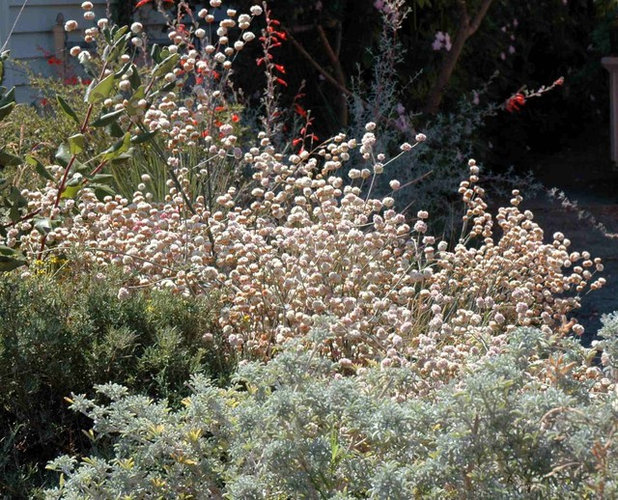
Pete Veilleux, East Bay Wilds
Naked Buckwheat
(
Eriogonum nudum)
Native in many plant communities throughout California and parts of Nevada, Oregon and Washington
Naked buckwheat’s large clusters of delicate creamy-white flowers bloom from spring through summer, feeding a circus of native bees, butterflies and other pollinators with its choice nectar and high-protein pollen. It’s wonderful in a perennial bed or in drifts. Be sure to site naked buckwheat where you can enjoy the wild and kooky show put on by summer pollinators.
Reliable and spritely, naked buckwheat requires full sun and well-drained soil. Once it’s established, water it once a month or not at all. With 3- to 6-inch basal leaves, its naked stems shoot up above the foliage for a mature bloom size of 2 to 5 feet high and 2 to 3 feet wide.
See how to grow naked buckwheat
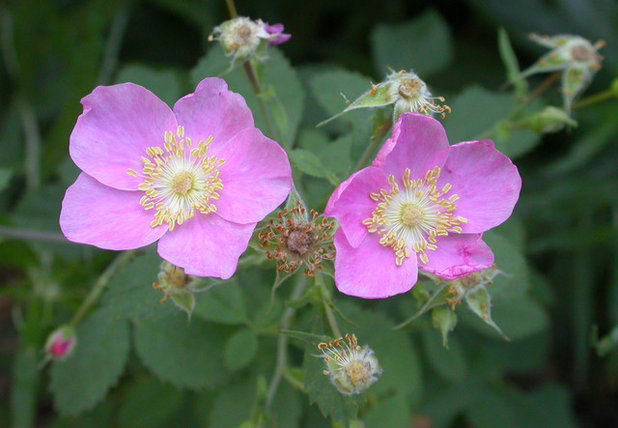 California Wild Rose
California Wild Rose
(
Rosa californica)
Native throughout California, except for the High Cascade Range and the High Sierra Nevada, generally in moist areas and stream banks
Given the fragrance, elegance and ease of native California roses, it’s surprising they aren’t used in gardens more often. Best planted next to a spring or natural waterway,
Rosa californica is particularly easy to grow. Give it at least a half day of sun, a natural waterway or irrigation every two to four weeks, and California wild rose will not only provide charming flowers, it will also attract birds and wildlife to its protective branches year-round and to its nutritious rose hips during winter.
Give California wild rose plenty of space to form a thicket. Due to its thorns, it makes a great barrier. It needs full sun on the coast and full sun to partial shade inland.
See how to grow California wild rose
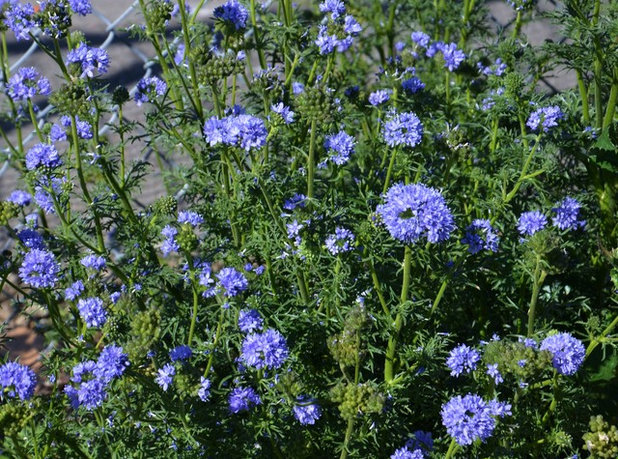
Pete Veilleux, East Bay Wilds
Globe Gilia
(
Gilia capitata)
Native throughout California and north to British Columbia and Idaho, growing on slopes in many plant communities
A long-blooming spring annual, globe gilia is a must for pollinator and butterfly gardens. Planted in full sun and in drifts of at least 3½ by 3½ feet, it becomes a neon sign calling all the native bees, butterflies and other pollinators for a feast of its yummy nectar. Although it does best in full sun with a drink every couple of weeks, it also does well with no water and even in partial shade.
Use globe gilia with perennials or other native annuals. Reaching from 6 inches to 2 feet tall and wide, globe gilia is a reliable self-sower and returns year after year.
See how to grow globe gilia





